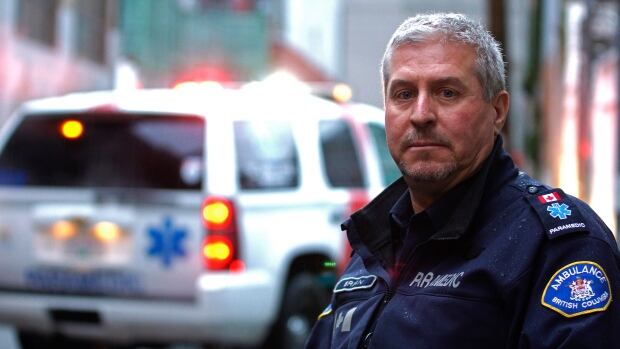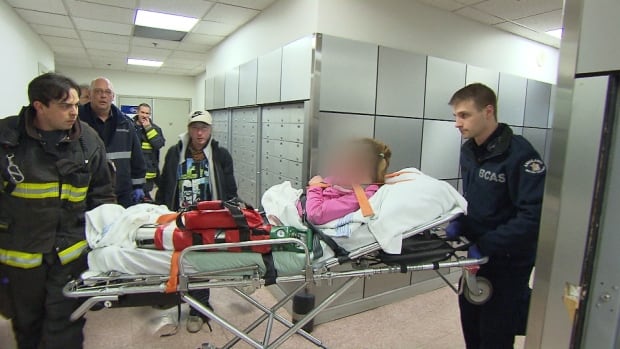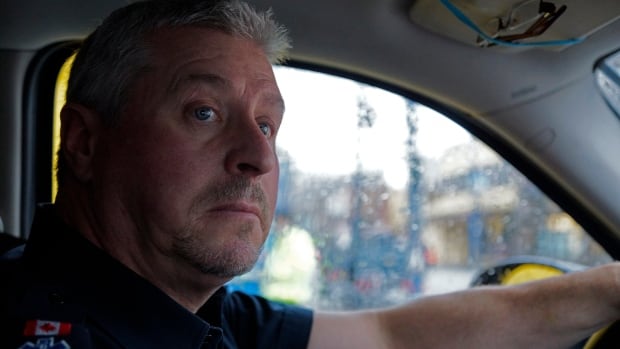B.C. paramedic’s secret to showing compassion for every overdose patient
Veteran paramedic Brian Twaites has his own way of coping with the unrelenting volume of traumatic drug overdose calls in B.C.
On a recent shift, where he dealt with a record 22 overdoses, he paused after a particularly emotional call after a young woman was found not breathing on the floor of a public washroom.
“I always think … whoever we are dealing with was at some point a little baby that was being bounced on someone’s knee,” said Twaites.
Twaites is one of 4,500 paramedics on the front lines of B.C.’s public health emergency during which a record 914 people died last year.
Twaites has no idea how many such deaths he has witnessed in his 30-year career.
“I’d hate to count that number.”
He allowed a CBC News crew to follow him on a shift, on condition the identity of his patients be protected.

Paramedic Brian Twaites remembers that every patient ‘was at some point a little baby that was being bounced on someone’s knee.’ (Peter Scobie/CBC)
911 overdose calls nearly double
B.C. paramedics responded to nearly 20,000 overdose calls in 2016, almost twice as many as in 2014.
- 2014 — 10,677
- 2015 — 12,263
- 2016 — 19,275
Twaites has special training in advanced life-support and travels alone in an SUV to back up other paramedics on complex calls.
“With these particular overdoses, they aren’t breathing and literally are quite close to death,” said Twaites.
During a call at a downtown mall at 4:45 p.m., he carries a $40,000 monitor that lets him “bring the emergency room to you.”
RAW VIDEO:
Paramedics work to revive a young woman who was found face down and not breathing in a public washroom in Vancouver0:46
“How are we doing? Got a pulse?” he asks the firefighters and paramedics who are already working on a young woman found face-down on the floor of a public washroom.
She has a pulse but is not breathing.
Twaites calmly draws up a shot of naloxone, also known as Narcan, and another paramedic administers it into her upper arm.
A firefighter watches while a second paramedic squeezes a bag valve mask to resuscitate her.
Twaites hooks up several leads to monitor her heart, blood oxygen level and blood pressure, and he can do an electrocardiogram or defibrillate if she goes into cardiac arrest.

A paramedic administer .8 ml dose of Naloxone into a woman who was found face down, not breathing in a public washroom in B.C. (Fred Gagnon/CBC)
A security guard tells him she’s been down for at least 15 minutes.
It takes another five minutes before she groans back to life.
“Hi hon! It’s OK. You were given Narcan, my dear …. You overdosed,” says a paramedic softly.
The woman, in her early 30s, breaks down sobbing.
“Some people are so shocked when they realize how close they have come,” says Twaites, as he packs up his gear.

‘You were given narcan my dear’ says a paramedic to a young woman who took 5 minutes to wake up after a shot of naloxone in her arm after a suspected fentanyl overdose. (Fred Gagnon/CBC)
“Another five or 10 minutes by herself in that bathroom without help, the outcome would have been quite tragic.”
That realization appears to sink in, and the woman’s sobs grow louder as she’s rolled on a stretcher toward a waiting ambulance.
“Please don’t leave me,” she screams to her friend, who earlier realized she was taking too long in the bathroom and alerted security.
The friend says she was just trying “to kill some nerves, to kill some stress or whatever, and she went under … let’s hope it doesn’t happen again.”

‘Don’t leave me’ cries a woman to her friend as paramedics transport the sobbing woman to an ambulance after she overdosed in a public washroom at a Vancouver mall. (Fred Gagnon/CBC)
He told CBC News he had overdosed that morning, but says he doesn’t carry or know how to use naloxone.
‘Paramedics are awesome’
“God’s got the recipe,” he shrugged as he climbed into the ambulance.
“Paramedics are awesome!” he shouted.
“One of the biggest things that leads to deaths is people who are fixing alone,” said Twaites, frustrated that users aren’t heeding the advice officials have been repeating since a public health emergency was declared last April.
Twaites believes deaths spiked in November and December because cold weather forced heroin, cocaine and meth addicts indoors to places where no one could see them collapse, if they used drugs laced with fentanyl.

Paramedics work to revive an overdose victim on Main Street in Vancouver on December 23, 2016, at the height of the worst month for overdoses in 2016. (G. P. Mendoza /CBC)
“That’s a sad thing … nobody wants to die alone,” says Twaites as he drives to another overdose call.
‘Deprivation of oxygen’ deadly
He says loved ones often make mistakes when trying to help.
“I’ve seen cases where people have gone running to get a Narcan kit instead of phoning 911, tragic outcomes, because there is a telephone in the lobby of the building, but they elected to run somewhere else to get a Narcan kit, says Twaites.
He says brain cells start to die after just a few minutes without oxygen.
“Quite often at the seven-minute mark, their heart has slowed down to the point where it has stopped and they are in cardiac arrest.”

‘No-one wants to die alone’ says Brian Twaites, an advanced life support paramedic in Vancouver. (Peter Scobie/CBC)
His advice is to call 911 first, and help the patient breathe until paramedics arrives.
“Narcan is great but what they need is oxygen,” he said. :The deprivation of oxygen is what is killing these people.”
Don’t be afraid to call 911
He also fears some users are afraid to call 911 for fear of arrest.
“We’re not here to report you …. Police aren’t worried about the fact that you’ve overdosed to get you in trouble,” warns Twaites.
By the time he shows up to his next call, the patient has taken off, on a city block where anyone in a uniform is not welcome.
“We gotta go, there’s stuff being thrown,” he says, and we drive away.
“It’s taxing, it’s physically taxing,” he says, but he explains that it helps that first responders watch each other’s back, like a family.
“The people we serve are family too, they look out for us too. You’d be surprised.”

CBC News Investigates
If you have information on this or any other story we should investigate, email us: [email protected]
Follow @NatalieClancy on TWITTER.